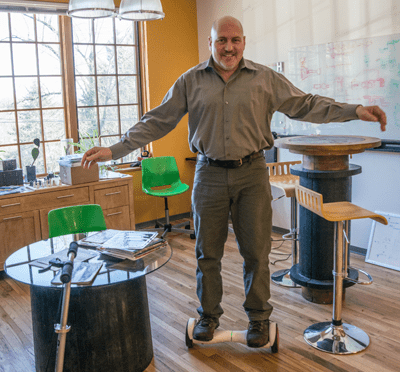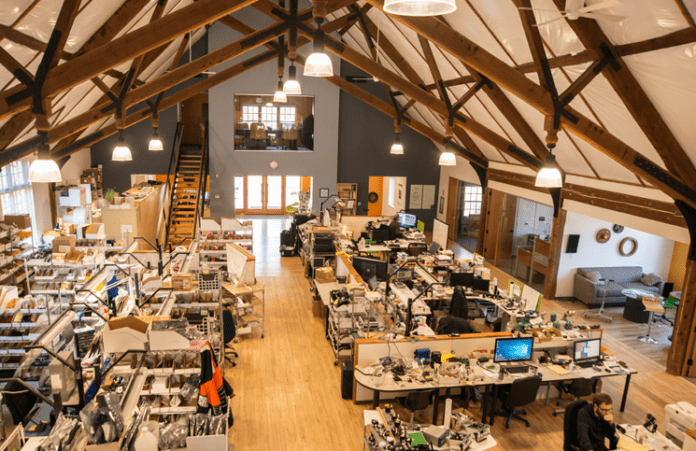Innovation begins with great ideas. Great ideas create better products, or simply improve internal processes that make a big impact on the overall success of a company.
In order to innovate, experts say companies must come up with ways to encourage feedback from their employees, their customers and distribution networks.
But if someone has an idea, and a company isn’t in a position to take action, the idea may not translate into a new products or policy.
“Nimbleness and innovation go hand-in-hand,” said Leonard Felix, president of Camas-based Felix Instruments, which designs and manufacturers tools to measure produce quality for growers, packers and handlers. “If our engineers invent something or the
marketing department conceives something, we can act on it and bring it to fruition.”
For example, Felix Instruments is currently looking to adapt infrared spectroscopy technology – used as a method to analyze produce – into the food and pharmaceutical industries.
And in the software industry, companies continuously update or improve technology to try to stay ahead of the competition.
“While you’re developing one product, you look at developing the next feature or update within three to six months,” said Chris Boyd, director of sales at Vancouver-based Circle Technology. “Tech innovation is about getting something done faster or more efficient.”
Product ideas from ‘the field’
Product ideas and improvements often stem from customer and distributor feedback. “[Distributors] tell us what they’re able to sell and what they want to sell,” said Felix.
Felix Instruments recently listened to feedback from a distributor to tweak a product in order for it to compete directly with a competitive product.
 The company soon removed an ethylene measure from a three-gas analyzer to appeal to customers exclusively interested in measuring carbon dioxide and oxygen levels.
The company soon removed an ethylene measure from a three-gas analyzer to appeal to customers exclusively interested in measuring carbon dioxide and oxygen levels.
“It’s fairly easy to take out our ethylene measure and compete in a whole new market,” said Felix. “It’s not something we would have thought about doing before.”
Screen sharing software company Circle Technology also consults distributors and customers to look at their pain-points and problems.
“What are their problems? How are they implementing technology? And what’s their workday look like?” said Boyd. “We have to develop something people will use, not something we think they would like.”
Often the most successful products are simple, which are challenging to develop, said Boyd. “You have to think about the end user. You don’t want to make a product too hard or too easy to use.”
This year, Circle Technology expects to launch new software that allows students and teachers to share monitor and device screens in the classroom. Distributors approached the company to create the product as a response to the demand for interactive learning technology.
“All of our distribution channels have a really big focus on education,” said Boyd. “So we developed new interactive learning and educational software based off the technology we already had.”
Out-of-office meetings
Some companies hold gatherings outside of the office to encourage employees to share ideas they may not come up with in a traditional office environment.
For example, Webfor, a digital marketing agency in Vancouver, hosts monthly happy hours and quarterly retreats. At its most recent retreat in January, employees determined the company’s top three limiting factors like lowering costs or improving customer service.
“The whole team brainstorms [three things we need to improve] and then refines a list into actionable items and there’s a deadline for one responsible party to implement the items,” said Kevin Getch, Webfor’s founder and director of digital strategy.
Getch’s team recently identified that the content management process it used for managing client projects contained too many bottlenecks. So its web development team proposed and implemented new project management software to eliminate client approval delays.
Open communication
Companies need feedback loops to ensure a new product or project is successful, or if a goal is met, said Getch.
“If you don’t have a feedback loop, you make changes in a vacuum and you don’t know if they are having positive effect,” he explained.
Part of Webfor’s feedback loop includes analyzing data and then suggesting changes to clients’ based conversation rates, for example.
Driving innovation forward also requires consistent communication.
Each department at Felix Instruments meets weekly to focus on departmental improvements, while monthly meetings address company-wide improvements. New product ideas often come out of engineering or marketing ideas. “And they typically get voiced at those weekly meetings,” said Felix.
The company also holds staff meetings at Camas Meadows and local restaurants, and employees meet once a month at a brewery.
“People think a lot differently when they’re at a new location. It creates new ideas and a new level of sharing,” said Felix.
When it comes to expressing ideas, not every employee is comfortable vocalizing their thoughts. So Webfor uses Suggestion Ox, an anonymous online suggestion box, to collect ideas as simple as painting the bathroom to as complex as changing how a specific project is managed.
Open spaces
Many companies have created work environments that promote collaboration, which often sparks new ideas.
Felix Instruments renovated its office in 2013 to feature pods with tables for employees to easily see others work areas. Employees can also take a break and ride one of the office’s hover boards or scooters.
“If people have an inkling of an idea on what others are doing, they might make a better decision that serves the good of the company as a whole versus addressing only individual requirements,” said Felix.
Webfor also has an open layout and coffee shop-style areas.
“Innovation is creating an environment where employees feel comfortable and encouraged to come up with ideas,” said Getch.



